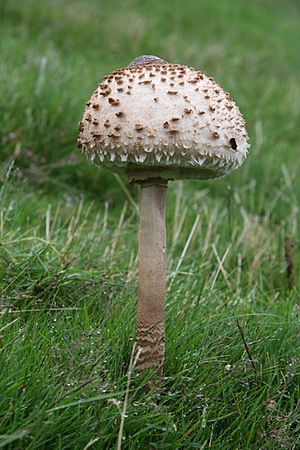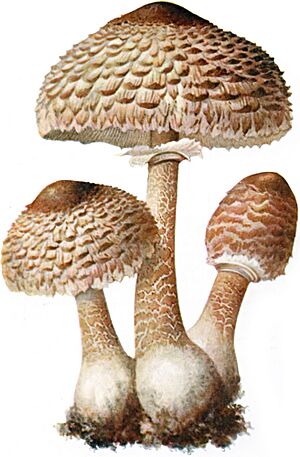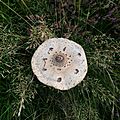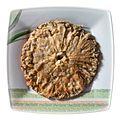Parasol mushroom facts for kids
Quick facts for kids Parasol mushroom |
|
|---|---|
 |
|
| A young parasol mushroom | |
| Scientific classification | |
| Genus: |
Macrolepiota
|
| Species: |
procera
|
| Synonyms | |
| Macrolepiota procera | |
|---|---|
| Mycological characteristics | |
| gills on hymenium | |
| cap is umbonate | |
| hymenium is free | |
| stipe has a ring | |
| spore print is white | |
| ecology is saprotrophic | |
| edibility: choice | |
The parasol mushroom, known scientifically as Macrolepiota procera, is a large and easily spotted fungus. It gets its name because its cap looks like an open parasol or umbrella. This mushroom is quite common in places with good soil drainage. You can find it growing alone or in groups, sometimes even in "fairy rings," in grassy areas and occasionally in forests. It grows all over the world in temperate (mild climate) regions.
Contents
What is the Parasol Mushroom?
The parasol mushroom was first described in 1772 by an Italian scientist named Giovanni Antonio Scopoli. He called it Agaricus procerus. Later, in 1948, another scientist named Rolf Singer moved it to the Macrolepiota group, which is where it is today.
How to Spot a Parasol Mushroom
This mushroom can grow very tall and wide. Both its stem and cap can reach up to 30 to 40 centimeters (about 12 to 16 inches) in height and width. Sometimes, they can even grow up to 50 centimeters!
The stem, also called the stipe, is thin but very strong. It grows to its full height before the cap fully opens. The stem has a cool pattern that looks like snakeskin. This is why some people call it the "snake's hat."
When the mushroom is young, its cap is round like an egg. As it grows, the edge of the cap breaks away from the stem. This leaves a loose, fleshy ring around the stem that you can often move up and down.
When the mushroom is fully grown, its cap flattens out. It usually has a chocolate-brown bump in the center, called an umbo. The top of the cap has dark, flaky bits that match the cap's color. These flakes can be easily rubbed off.
The gills underneath the cap are crowded and white, sometimes with a light pink color. When the mushroom releases its spores, they are white. The mushroom has a pleasant, nutty smell. If you cut the white flesh, it might turn a pale pink color.
Is it Safe to Eat?
Yes, the parasol mushroom is a very popular and tasty edible mushroom. People in Europe especially like it because it's big, easy to find during its season, and can be cooked in many ways. In the UK, you can find it from July to November.
It's usually hard to confuse the parasol mushroom with other types, especially in Europe. This is because a poisonous mushroom that looks similar, called Chlorophyllum molybdites, is rare there. The C. molybdites mushroom has gills and spores that look greener.
Important Safety Tip: Always be very careful when picking any mushroom to eat. It's best to go with an expert or use a trusted guide to make sure you have the right mushroom. You should never eat a mushroom raw unless you are absolutely sure it is safe.
Cooking with Parasol Mushrooms
The parasol mushroom is a favorite in many kitchens. People often sauté (lightly fry) the caps in melted butter. In parts of Central and Eastern Europe, they prepare it like a cutlet. They dip it in egg and breadcrumbs, then fry it in a pan.
In Slovakia, a popular recipe is to bake the caps stuffed with ground pork, oregano, and garlic. Italians and Austrians also stuff the young, round caps with seasoned minced beef and bake them.
While the cap is great for cooking, the hollow, fibrous stem and the bulb at the bottom are often thrown away. However, you can dry these parts and grind them into mushroom powder. This powder can be used to add flavor to soups, stews, and sauces.
Mushrooms That Look Similar
There are a few other mushrooms that look a bit like the parasol mushroom. It's important to know the differences, especially for safety.
- The shaggy parasol (Chlorophyllum rhacodes) is smaller but looks similar. It doesn't have the snakeskin pattern on its stem. Its flesh turns reddish when cut, and it has a strong, fruity smell. Some people get sick from eating it, especially if it's raw.
- Macrolepiota mastoidea is another large edible mushroom found in Europe. It's usually smaller than the parasol mushroom. The markings on its stem are not as clear, and it's much rarer.
- Mushrooms in the Agaricus group have brown spores. Their gills are never white when they are fully grown.
Poisonous Look-Alikes
Some poisonous mushrooms can be mistaken for the parasol mushroom. Be extra careful with these:
- Chlorophyllum molybdites is a poisonous mushroom that causes many poisonings in North America. It looks very much like the parasol mushroom. You can tell it apart by its slightly green gills and pale green spore print. It also doesn't have the snakeskin pattern on its stem. This mushroom is now spreading into Europe.
- Leucocoprinus brunnea, found in North America, slowly turns brown when you slice it.
- Young, white mushrooms from the Amanita group can also be dangerous. To be safe, only pick parasol mushrooms that are past their very early "button" stage. A good tip is that parasol mushrooms have darker flakes on a lighter cap surface. Amanita species, like the Panther cap, usually have lighter flakes (if any) on a darker surface. However, this rule doesn't apply to all Amanita species, like Amanita smithiana.
- The Saffron Parasol (Cystoderma amianthinum) is much smaller and not often eaten.
- Lepiota brunneoincarnata is a much smaller mushroom that has caused deadly poisonings in Spain.
Gallery
See also
 In Spanish: Apagador para niños
In Spanish: Apagador para niños












